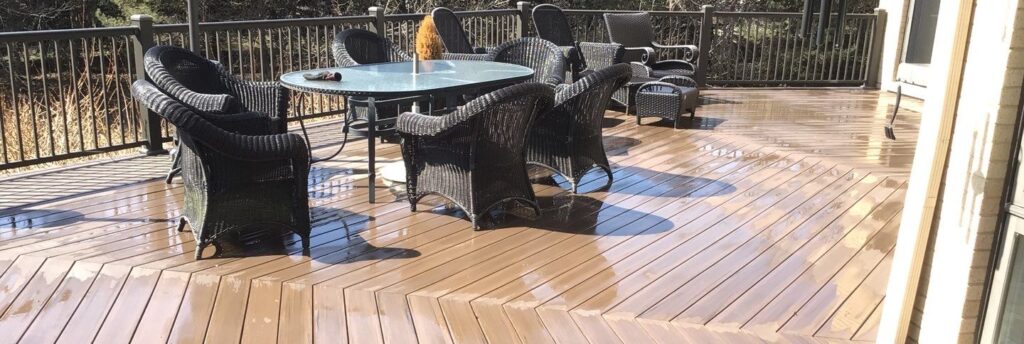You have to make a big decision when it comes to deck construction or deck renovation: composite decking or traditional wood decking? Both materials have advantages and disadvantages, and choosing the right one can make your deck last a long time, look good, and be easy to take care of. We will help you make an informed choice for your project by exploring the pros and cons of composite and natural wood decking.
The Growing Popularity of Composite Decking
Recently, the market for decking materials has grown a lot. People can choose from many different types of products, such as plastic composites and natural wood products. This diversification shows the growing demand for solutions for outdoor living spaces that are innovative and last a long time. Although composite materials are often more expensive than their natural wood counterparts, they offer a compelling value proposition due to their superior durability and lower maintenance requirements. Homeowners are increasingly interested in a deck that can last for a long time and withstand environmental challenges without needing constant attention. More and more homeowners decide on ordering decking services to convert decking to composite.

However, it is essential to recognize that wood is still a prevalent choice for decking. Its timeless appeal and familiarity continue to attract homeowners. However, choosing to use wood has some downsides. Wood decks look warm and natural, but they need regular care and maintenance to keep their integrity. The choice between composite and natural wood depends on many things like what you like, how much you can spend, how you want it to look, and how you care about the environment. So, when you start a decking project, you need to choose between these materials carefully, taking into account your unique circumstances and long-term needs.
Every homeowner should know that: Are asphalt shingles a good choice?
Composite Decking

Low Maintenance
One of the greatest advantages of composite boards is that it requires minimal maintenance. Natural wood needs to be stained, painted, and replaced regularly, but composites save you from these labor-intensive tasks. If you’d rather spend your time enjoying your deck instead of keeping it clean, composites are a good choice.
Color Variety
The decking material is available in a diverse range of colors. Composites don’t need painting or staining to match your home’s exterior. They look the same without these extra steps. Pick from a variety of shades to match your outdoor area. The most popular composite planks colors are brown, reddish-brown, white, and gray. If you have an older generation composite deck board without a plastic cap or shell, you can paint or stain it.
Environmentally Friendly Options
It is made of a combination of recycled plastic and wood, which makes it a low-impact option. The use of recycled materials in composite decking helps reduce the amount of waste entering landfills and the larger environment. The wood content of most composite decking is reclaimed material, so there is no need to cut down trees to produce it, which helps preserve natural forest.
Composite decking is also durable and long-lasting, which means that it doesn’t need to be replaced by decking specialists as frequently as traditional wood terrace. This reduces the amount of waste generated from deck replacements and contributes to a more sustainable future. Moreover, composite decking is chemical-free and can be cleaned with regular soap and water, which keeps undesirable chemicals out of the water and soil. Some composite deck boards are even made from up to 100% recycled materials, making them of up to 80% recycled content.
Improved Technology
The advancements in composite technology have resulted in the production of decking that comprises a hard plastic shell that is bonded to composite boards, thereby enhancing its durability. These improvements keep your composite deck looking great.
Wood Plastic Composite
- Fibers from wood pulp, bamboo, bark or nut hulls are combined with plastic powder.
- Lumber composites are environmentally friendly because they are made from natural fibers, some of which can come from waste materials
- The process of cutting, drilling, nailing, or screwing is similar to that of natural wood.
- It can be less weather-resistant than some non-wood decking options.
Cellular PVC
- The synthetic wood used for decks is widely used due to its high density honeycomb structure, which is made from polyvinyl chloride (PVC)
- It has excellent resistance to water, rot, and insects.
- You can paint it if you want, and it works like wood when you work with it.
- The mineral-based plastics are more eco-friendly than the ones made from petroleum.
Mineral-Based Composite (MBC)
- MBC is known for its strength and stability.
- This decking is impervious to water and insect attacks.
- The material can be colored or textured so that it looks like wood.
- The material is composed of a combination of plastics and minerals, however, it is entirely inorganic
Wood Decking
With its warm and inviting appearance, wood decking complements outdoor spaces with its timeless and natural beauty. The rich grain patterns and colors of wood create a warm and inviting atmosphere. The wood’s versatility enables customization to align with various architectural styles, and it can be stained or painted in a wide range of colors to achieve the desired ambiance. Wood terrace can be a green option when sourced ethically, and many wood varieties are regenerative. The ease of maintenance and replacement, as well as their value, make them sustainable.
Wood also retains its temperature in the sun, thereby facilitating comfort during scorching summer days. Such a decking is a popular choice for outdoor living spaces because of its classic appeal, traditional charm, and the way it ages gracefully.

A tutorial for you: Why it’s important to prepare a home for winter?
Hardwood decking
The longer it takes to grow a hardwood, the denser and more resistant it is to decay, making them ideal for decking. Hardwood decks are usually more expensive at first, but they will probably last a lot longer without needing much maintenance. Hardwoods are usually popular with people who want something different and classy and who don’t care about price.
Softwood decking
The density of softwoods comes from conifers such as pine trees and Douglas firs, which are lighter and not good for use in construction.
The cedar wood, a softwood with a high resistance to rot or termite damage, is currently the most widely utilized wood for construction purposes. Cedar has been a traditional choice due to its affordability and ease of use.

Pine is another very popular softwood, which is cheaper than hardwoods, but requires more maintenance because it doesn’t last as long as hardwoods.
There is a lot of maintenance required to keep softwood decking in good condition. They need regular sanding, staining, and sealing, which can get pricey over time.
Pressure treated wood decks
You might have heard that some wood is called “pressure treated,” but what does this mean? It is usually soft wood, and it’s been treated to prolong its life. Pressure treated boards have undergone a chemical treatment that involves chemically soaking them in water and incorporating preservatives to prevent rot when exposed to elements such as rainwater, moisture in soil, or damp air.
Cost Considerations
The cost of both composite and wood decking is often a significant factor. Wood decks are expensive to buy at first, but it’s important to think about the long-term costs. Wood decks need to be painted, stained, and sealed regularly to keep weather and pests out. Even though composite decking is more expensive at first, it usually pays for itself in a few years when you add up the maintenance costs.
The cost can vary depending on the wood type and the brand of composite boards you choose.
Maintenance and Durability
Wood Decking
- Painting, staining, and sealing are all necessary to keep the house safe from temperature, moisture, and pests.
- Wood decks usually last 10 to 20 years, depending on the type of wood and how well it is taken care of.
- Increasing wood deck longevity can be achieved by using pressure-treated lumber and considering more durable wood species like cedar, redwood, ipe and cumaru.
Composite Decking
- Composite decking generally requires less maintenance than wood.
- The materials are capped, providing additional protection and enduring durability.
- Although they exhibit greater durability, they are not entirely maintenance-free. For example, composite materials are prone to staining and mold growth.
- Composite decks may experience scratches, dents, and other damage, which require some care and attention to maintain their appearance.
Temperature Considerations
The sun’s intense rays can indeed lead to thermal expansion in various decking materials. However, it’s noteworthy that composite materials, known for their durability and low maintenance, have a tendency to absorb and retain more heat than traditional wood. This heat retention can result in uncomfortably hot deck surfaces, making them less enjoyable to walk on, particularly during sweltering summer days when temperatures soar.

Fortunately, composite decking manufacturers are actively addressing this issue. They have been developing innovative solutions to mitigate heat absorption, aiming to create a more pleasant experience for those who wish to savor their outdoor spaces without discomfort. These advancements include technologies that reduce the heat retention of composite decking by up to 35% compared to conventional capped composites in similar colors.
Environmental Impact
The type of decking you choose is an important consideration. Wood is a renewable resource, but it is essential to ensure that it is sourced responsibly. Some wood treatments can be toxic, and some exotic woods may be illegally logged. On the other hand, composites can vary in their environmental impact. Compared to petroleum-based chemicals, certain brands emphasize recycled materials and eco-friendly manufacturing methods. It’s important to research the eco-friendliness of the brand you choose.

Before starting your deck project, look at different decking materials, think about what you need and want, and think about the long-term costs and benefits. Whether you opt for the natural beauty of wood or the toughness of composite decking, your choice will have a lasting impact on your outdoor living area. Decking services offer contact information, allowing you to reach out to professionals who can provide personalized advice and guidance based on your unique project requirements.

